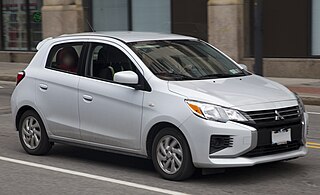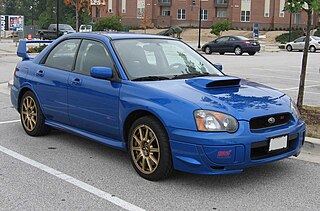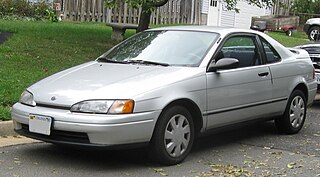
The Mazda RX-8 is a sports car manufactured by Japanese automobile manufacturer Mazda between 2003 and 2012. It was first shown in 2001 at the North American International Auto Show. It is the direct successor to the RX-7. Like its predecessors in the RX range, it is powered by a rotary Wankel engine. The RX-8 was available for the 2003 model year in most parts of the world.

The Mitsubishi Lancer Evolution, popularly referred to as the 'Evo', is a sports sedan and rally car based on the Lancer that was manufactured by Japanese manufacturer Mitsubishi Motors from 1992 until 2016. There have been ten official versions to date, and the designation of each model is most commonly a Roman numeral. All generations use two-litre intercooled turbo inline four-cylinder engines and all-wheel drive systems.

The Mitsubishi Eclipse is a sport compact car that was produced by Mitsubishi in four generations from 1989 until 2011. A convertible body style was added during the 1996 model year.

The Mitsubishi Galant is an automobile which was produced by Japanese manufacturer Mitsubishi from 1969 until 2012. The model name was derived from the French word galant, meaning "chivalrous". There have been nine distinct generations with total cumulative sales exceeding five million units. It began as a compact sedan, but over the course of its life evolved into a mid-size car. Initial production was based in Japan, with manufacturing later moved to other countries.

The Mitsubishi Magna is a mid-size car that was produced over three generations between 1985 and 2005 by Mitsubishi Motors Australia Limited (MMAL). Developed as a replacement for the Mitsubishi Sigma, each Magna generation derived from Japanese platforms re-engineered for the Australian market and conditions. Initially, Magna offered inline-four engines in a mid-size sedan package—a station wagon debuted in 1987. Over the years, each new series grew in size, and with the second generation of 1991, the range was bolstered by a luxury variant called Mitsubishi Verada and a V6 engine. The Magna/Verada became the first Australian-made vehicle to be exported worldwide in large numbers, predominantly as the Mitsubishi Diamante. The third and final iteration Magna/Verada launched in 1996, adding all-wheel-drive (AWD) from 2002, and receiving a substantial styling update in 2003. They were replaced by the Mitsubishi 380 in 2005.

The Mitsubishi Starion is a two-door, turbocharged four-cylinder rear-wheel drive four-seat fastback sports car manufactured and marketed by Mitsubishi from 1982 until 1989 — with badge engineered variants marketed in North America as the Conquest, under the Chrysler, Dodge, and Plymouth brands.

The Mitsubishi Lancer is an automobile that was produced by the Japanese manufacturer Mitsubishi Motors from 1973 until 2024.

The Mitsubishi Colt is a nameplate from Mitsubishi Motors that has been applied to a number of automobiles since 1962. It was first introduced with a series of kei and subcompact cars in the 1960s, and then for the export version of the subcompact Mirage between 1978 and 2002. Chrysler, Mitsubishi's longtime partner, also used the name when applying its long-running practice of rebadging Mitsubishi vehicles as the Dodge and Plymouth Colt captive imports for the North American market between 1970 and 1994.

The Mitsubishi Mirage is a range of cars produced by the Japanese manufacturer Mitsubishi from 1978 until 2003 and again since 2012. The hatchback models produced between 1978 and 2003 were classified as subcompact cars, while the sedan and station wagon models, marketed prominently as the Mitsubishi Lancer, were the compact offerings. The liftback introduced in 1988 complemented the sedan as an additional compact offering, and the coupé of 1991 fitted in with the subcompact range. The current Mirage model is a subcompact hatchback and sedan and it replaces the Mitsubishi Colt sold between 2002 and 2012.

The Mitsubishi Sirius or 4G6/4D6 engine is the name of one of Mitsubishi Motors' four series of inline-four automobile engines, along with Astron, Orion, and Saturn.

The Chrysler Sigma is a version of the Mitsubishi Galant automobile that was built by Chrysler Australia in Adelaide, South Australia from 1977. When Mitsubishi Motors Australia (MMAL) took over Chrysler Australia's manufacturing facilities in 1980, they renamed the vehicle the Mitsubishi Sigma. The range was progressively discontinued and replaced by the Mitsubishi Magna, starting with the sedan in 1985 and the wagon in 1987.

The Subaru Impreza WRX STI is high performance specification model of the Subaru Impreza compact car line, manufactured by Japanese automaker Fuji Heavy Industries Subaru.

The Hyundai Tiburon, known in Europe as the Hyundai Coupé, is a sports coupe that was produced by the South Korean manufacturer Hyundai from 1996 to 2008.

The Toyota Paseo is a sports-styled subcompact car sold from 1991 until 1999 by Toyota and was directly based on the Tercel. It was available as a coupé and in later models as a convertible. Toyota stopped selling the car in the United States in 1997, however the car continued to be sold in Canada, Europe and Japan until 1999. The Paseo, like the Tercel, shares a platform with the Starlet. Several parts are interchangeable between the three.

The Mitsubishi Galant VR-4 was the range-topping version of Mitsubishi Motors' Galant model, available in the sixth (1987–1992), seventh (1992–1996) and eighth (1996–2002) generations of the vehicle. Originally introduced to comply with the new Group A regulations of the World Rally Championship, it was soon superseded as Mitsubishi's competition vehicle by the Lancer Evolution, and subsequently developed into a high-performance showcase of the company's technology.

The Mitsubishi 4B1 engine is a range of all-alloy straight-4 piston engines built at Mitsubishi's Japanese "World Engine" powertrain plant in Shiga on the basis of the Global Engine Manufacturing Alliance (GEMA). Although the basic designs of the various engines are the same, their exact specifications are individually tailored for each partner. The cylinder block and other basic structural parts of the engine were jointly developed by the GEMA companies, but the intake and exhaust manifolds, the cylinder head's intake and exhaust ports, and other elements related to engine tuning were independently developed by Mitsubishi.

Twin Clutch SST is the brand name of a six-speed dual-clutch automatic transmission, developed by Getrag for Mitsubishi Motors. The system was first incorporated in the 2008 Lancer Evolution X, and was designed to be a more performance-oriented system than that developed by rival manufacturers, with shorter gear ratios optimized for acceleration.

The Mitsubishi Lancer (A70) is the first generation version of Mitsubishi's long-running Lancer nameplate. When introduced in 1973, it filled the gap between the Minica kei car and the considerably larger Galant. It was a replacement for the Colt 1200, last sold in 1970. Although sedan production ended in 1979, vans continued on until 1985. This Lancer also formed the basis for the Lancer Celeste sports coupé of 1975 through to 1981. These Lancers were sold under a multitude of names in different markets.

The Mitsubishi Lancer WRC is a World Rally Car built by Ralliart, Mitsubishi Motors' motorsport division, to compete in the World Rally Championship. The previous Lancer Evolution series were homologated for the Group A class, and their competitiveness against World Rally Cars from other manufacturers was therefore limited.

The second generation of the Subaru Impreza compact car was introduced in 2000 and manufactured up to 2007 by Subaru in Ōta, Gunma, Japan, in both sedan and five-door Hatchback bodystyles, as well as two intermediate facelifts throughout its lifespan.























